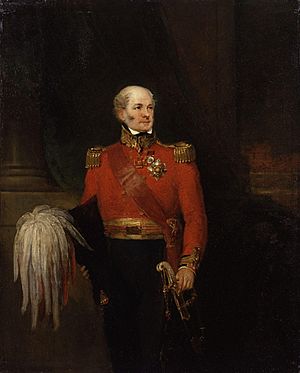John Lambert (British Army officer, born 1772) facts for kids
Quick facts for kids
John Lambert
|
|
|---|---|
 |
|
| Born | 28 April 1772 |
| Died | 14 September 1847 (aged 75) |
| Allegiance | Great Britain |
| Service/ |
British Army |
| Rank | General |
| Unit | 1st Foot Guards (1791–?) |
| Commands held | 6th Division brigade, 10th Brigade |
| Battles/wars | |
| Awards |
|
General Sir John Lambert (28 April 1772 – 14 September 1847) was an important officer in the British Army. He fought in many major wars, including the French Revolutionary Wars, the Napoleonic Wars, and the War of 1812. He is especially remembered for his brave actions at the Battle of Waterloo, where he helped keep a vital path open for the Allied army.
Contents
Early Military Career
John Lambert joined the British Army on 27 January 1791. He started as a young officer, called an ensign, in the 1st Foot Guards. He quickly moved up the ranks, becoming a lieutenant and then a captain in 1793.
He fought in important battles during the French Revolutionary Wars. These included the sieges of Valenciennes and Dunkirk. He also took part in the Battle of Lincelles in 1793. Later, he served in the Irish Rebellion of 1798 and an expedition to Holland in 1799.
Napoleonic Wars and Promotions
Lambert continued to rise in rank, becoming a lieutenant-colonel in 1801. He served in Portugal and Spain in 1808, fighting in the Battle of Corunna. He also led light companies of the guards in the Walcheren expedition of 1809.
By 1810, he was promoted to colonel. In 1811, he commanded a battalion in Spain. He joined Wellington's army in Salamanca in October 1812.
In 1813, he became a major-general and led a brigade in the sixth division. He commanded troops in several key battles of the Peninsular War. These included the Battle of Nivelle, the Battle of the Nive, Battle of Orthez, and Toulouse. For his bravery, he was mentioned in official reports and received the Army Gold Cross. He was also made a Knight Commander of the Order of the Bath in 1815.
War of 1812 in America
After his service in Europe, Lambert was sent to America. He joined the army at the Battle of New Orleans in January 1815. He commanded the reserve troops during a difficult attack on American defenses.
After the main commanders were killed or badly wounded, Lambert took charge. He decided not to attack again. Instead, he carefully pulled back his troops. He then moved to Mobile Bay, where his forces captured Fort Bowyer. Soon after, news arrived that a peace treaty had been signed, ending the war.
Battle of Waterloo
Lambert returned to Europe just in time to fight in the famous Battle of Waterloo. He commanded the tenth brigade of British infantry. His brigade arrived on the morning of the battle, 18 June 1815.
His troops were first held in reserve. Later in the afternoon, they moved to the front lines. They supported other British forces, especially near the important farm of La Haye Sainte. The French army captured this farm and then fired cannons at the British lines from very close range.
Lambert's brigade, though taking heavy losses, held their ground. They were described as "lying dead in a square" but did not break. Their stand was crucial for keeping the Allied army's position strong. For his actions at Waterloo, Lambert was again praised by Wellington. He also received special awards from other countries, like the Order of St. Vladimir and the Military Order of Max Joseph.
Later Life and Family
Lambert continued to serve in the army. He was promoted to lieutenant-general in 1825 and then to general in 1841. He received the highest honor of the Order of the Bath, the Grand Cross of the Bath (G.C.B.), in 1838.
He passed away on 14 September 1847, at the age of 75.
In 1816, John Lambert married Mary Morant. He came from a family of military men. His younger brother, Henry Lambert, and older brother, George Lambert, were both officers in the Royal Navy.
Cricket
Besides his military career, John Lambert was also a keen amateur cricket player. He played in 12 known first-class cricket matches between 1794 and 1810. He was mainly associated with the Marylebone Cricket Club (MCC).

